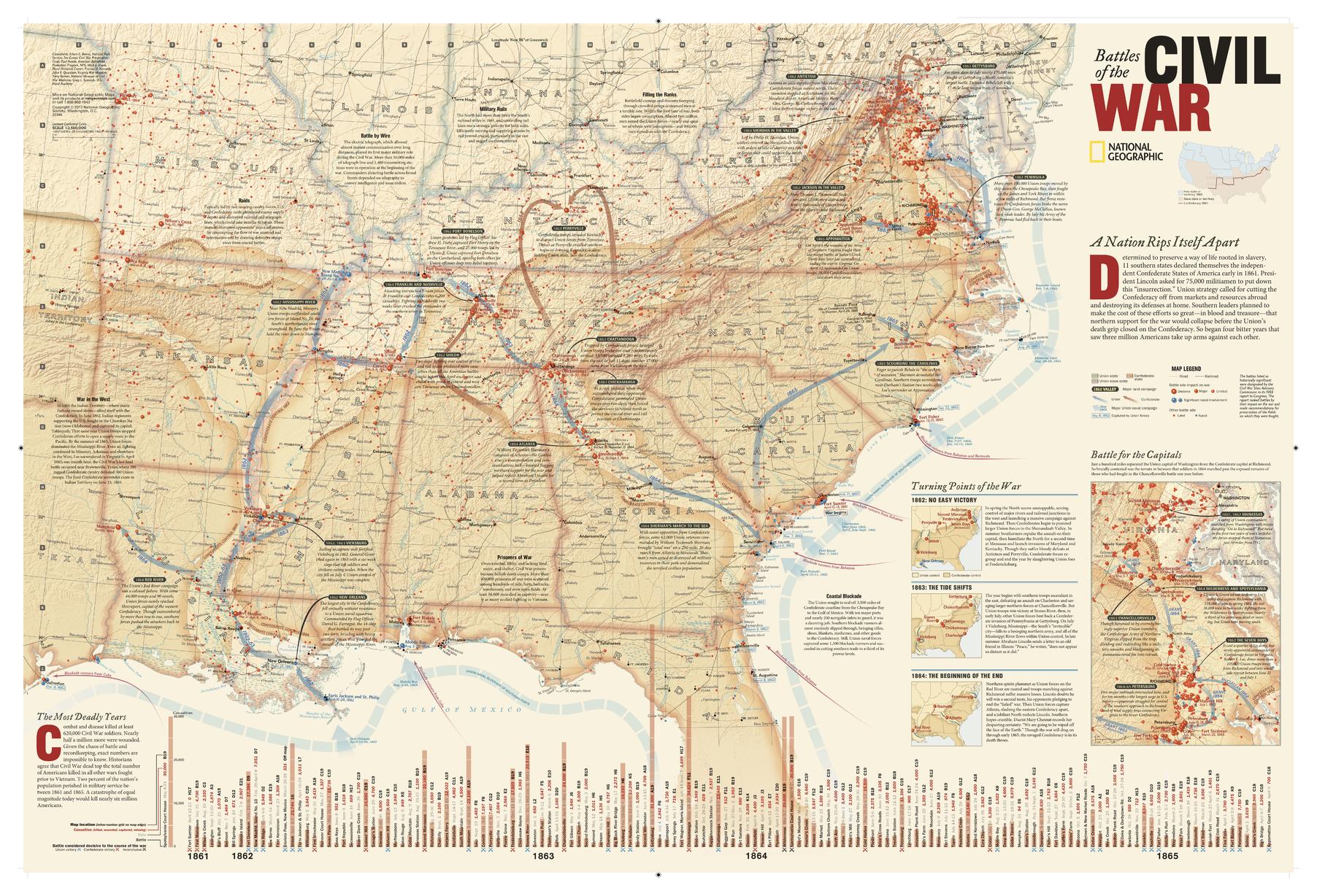When I joined the beta test of Strategic Command American Civil War, I was skeptical about the ability of the game to represent the Civil War in a viable, believable manner. I was concerned that the Strategic Command standard limitations of no stacking and no unit combinations, which have been criticized by some in Fury's other games as well as this one, would provide a totally unrealistic and "broken" playing experience for the Civil War. I was wrong.
What I found in playing the game extensively in the beta test is that on a strategic and operational level the game feels "right." It presents the challenges and decisions one would expect from a strategic level Civil War game. That is in line with the description of the game from the Matrix site: "In this turn-based strategy game, you will control the armies, research, production and diplomatic policy of either the Union or the Confederacy during a time of great innovation and dramatic battles."
The game does not present a realistic tactical level of play, but then it is not a tactical level game. Instead the game abstracts the tactical level of play to provide a remarkable game at the operational and strategic level. I went in skeptical, and by the time I had finished my first game, I was convinced the game developers got it right.
There will certainly be detractors, including those who see the failure to allow stacking and unit combination as indefensible shortcomings. The same criticisms have been made about other SC games, but will be made more about a game based on 19th Century warfare. There is concern that due to the no stacking rules that the game will bog down into a WWI style affair with long continuous fronts. I understand those criticisms, and I know sometimes it just comes down to personal preference. But beyond personal preference, let me briefly relate how SC ACW provides a wonderful strategic and operational game experience while abstracting tactical combat.
First let me define some terms. Department of the Army Field Manual 1-02.1,
Operational Terms, March 2021 (link at end of post), contains the following definitions:
Strategic level of warfare – The level of warfare at which a nation, often as a member of a group of nations, determines national or multinational (alliance or coalition) strategic security objectives and guidance, then develops and uses national resources to achieve those objectives.
Operational level of warfare – The level of warfare at which campaigns and major operations are planned, conducted, and sustained to achieve strategic objectives within theaters or other operational areas.
Tactical level of warfare – The level of warfare at which battles and engagements are planned and executed to achieve military objectives assigned to tactical units or task forces.
Let's start with the strategic level. SC ACW provides an excellent strategic level experience on a huge map. Per the game description: "Strategic Command: American Civil War comes with a massive 66,000 hex map, covering all of North America from Canada and New Mexico to the Caribbean at a 15km/9mi scale. This is the largest hex-based map ever offered by the Strategic Command series!" On this huge map, players have to determine their strategic objectives.
As the Union player, you will have to decide what your main objectives are. How much effort will you put into the blockade? Will you conduct amphibious operations? Where will you make your main offensive efforts? Toward Richmond? Nashville? The Mississippi River? The player will then have to develop and use national resources to achieve those objectives, through unit production and placement and research, as well as replacements and unit upgrades. The player will also have to conduct diplomacy with European nations and Native American tribes.
The CSA player will be faced with similar decisions and choices, mostly involving defending key objectives, but CSA players must also determine to what extent they will conduct offensive operations. There is also the question of whether the blockade will be challenged and how much emphasis to place on research and diplomacy.
At the operational level, once the strategic objectives have been determined, the player will have to bring military forces to bear in major campaigns and other operations to sustain those strategic objectives. If seizing Nashville is a strategic Union objective, then how to do it? Go straight at it? Use the rivers and advance on the flanks? How much combat power will you put into taking Nashville, and at what cost to other offensive operations? What generals will you place in command of the operation?
Likewise, if holding Nashville is a stategic CSA objective, how will that be done? By advancing forward into Kentucky at the earliest opportunity? By establishing a strong defensive line along the Cumberland River? By attacking the Union supply line?
At the same time, each player must ensure forces are deployed to prevent the opposing side from using weak points and openings to attain their own strategic goals or to exploit an operational opportunity, and there are many openings to exploit in this game. This is the core of the operational game -- building forces to seize or hold strategic objectives and then moving those forces into position to attain those objectives through maneuver and combat.
At the tactical level, the game is abstracted. For a game played with units primarily representing large formations, especially once corps are available, and with leaders representing primarily army level leaders, and with the scale of the map, this is to be expected. But within the limitations of the map scale, the force sizes, and the game rules (no stacking, no combining units, etc.), the game abstracts the tactical level very well. Operations even on a large scale will often involve "battles" that come down to an attempt to seize or defend a single hex. This situation is abstracted well with attacks from multiple hexes on a single turn allowed, and with the swapping of adjacent units to continue combat against a single hex in waves. If you can accept this abstraction and just play the game, you will find that on an operational and strategic level, the game is oustanding.
To give an example, in a recent game as the CSA, I made a strategic decision to seize Ft. Monroe from the Union. Operationally I then moved four infantry divisions under Lee to face the Union brigade defending in fortifications outside Ft. Monroe. I placed two divisions adjacent to the Union brigade with a division behind each front line division. Then I attacked, first with each frontline division, and then via the swapping mechanism with each reserve division. It took all four attacks, backed by Lee's leadership values, to eliminate the fortified Union brigade and seize the fortifications. After that, eliminating the Union headquarters unit in Ft. Monroe was easy. The abstracted battle involved four divisions assaulting one hex in waves, an abstracted tactical battle that was the culmination of the operation resulting from the strategic decision to take Ft. Monroe.
Finally, let's discuss the idea that the game will bog down into a WWI style game of lengthy extended lines. To be honest, in some respects this will indeed happen in the East and happened in the war itself to some extent. I'll get back to that. In the West, however, the map is so large in comparison to the number of units available, that a continuous line never develops, and there is always room to conduct extended operations into the enemy's rear. It is just a matter of finding areas that can be exploited. The AI is very good at this, by the way.
But back to the East, the distance from Alexandria VA to Cumberland MD is 11 hexes. This provides avenues of approach straight from Alexandria to Richmond, to the west from Frederick toward Culpepper, and further west down the Shenandoah Valley from Antietam toward Winchester and further south. But it is still just 11 hexes, so both sides will be able to position units in a continuous line on that front if they are do inclined. By comparison, the distance from London KY to the Mississippi River south of Cairo IL is 26 hexes. And the distance from New Madrid MO to Joplin MO is 24 hexes.
Considering the size of the forces that will be deployed in the East to protect Washington and Richmond, it will be much harder to conduct extended operations with deep penetrations, though they can occur with careful planning or if your opponent leaves an opening. If one side does try to form a continuous line, it can be broken if the other side masses forces to create an opening and then exploit it, but the exploitation of the opening will likely be difficult because the East is a narrow area of operations in the northern Virginia area that will likely be heavily defended by both sides.
And in the actual war, despite the fact that there were no long, continuous lines, there just weren't very many large, extended operations conducted in the East, though many were attempted, in part because the terrain compared to the forces involved prevented many successful operations. With the exception of the Gettysburg campaign, there is really no good example of a large force making a deep penetration in the East before 1864. Several offensives were attempted, but most failed.
In game map distance, most of the campaigns in the East were conducted within a 7-hex radius of Manassas, which includes Antietam, Little Round Top south of Gettysburg, and Richmond. For most of the period from 1861 to Grant's 1864 offensive and the 1864 Shenandoah campaigns, the situation was essentially a stalemate in the East with no significant strategic gains by either side. And Grant's 1864 campaign devolved into a stalemate along a 30-mile front for nearly a year.
Meanwhile, in the West, there are many ways both sides can conduct operations. The Union AI will often conduct offensives southward along the Mississippi River toward Memphis, southward and then eastward along the Cumberland River, directly toward Nashville, and east of Nashville along a couple of different possible paths, often simulaneously. Likewise the trans-Mississippi has multiple widely separated avenues of advance. The Confederacy can also use these same avenues to conduct offensives to disrupt US plans and possibly seize key locations. The same offensive and defensive operational possibilities available during the war are available to both sides.
A look at the attached National Geographic Civil War map gives a good idea of the major offensive operations conducted in the war. Look at the East compared to the West.
In, conclusion, after taking part in the beta test and playing several full games as both North and South, I believe SC ACW does an outstanding job of portraying the Civil War as a wargame at the strategic and operational levels. That is what it is meant to do, and it does that well.
*Link to FM 1-02.1 https://armypubs.army.mil/epubs/DR_pubs ... -WEB-1.pdf









